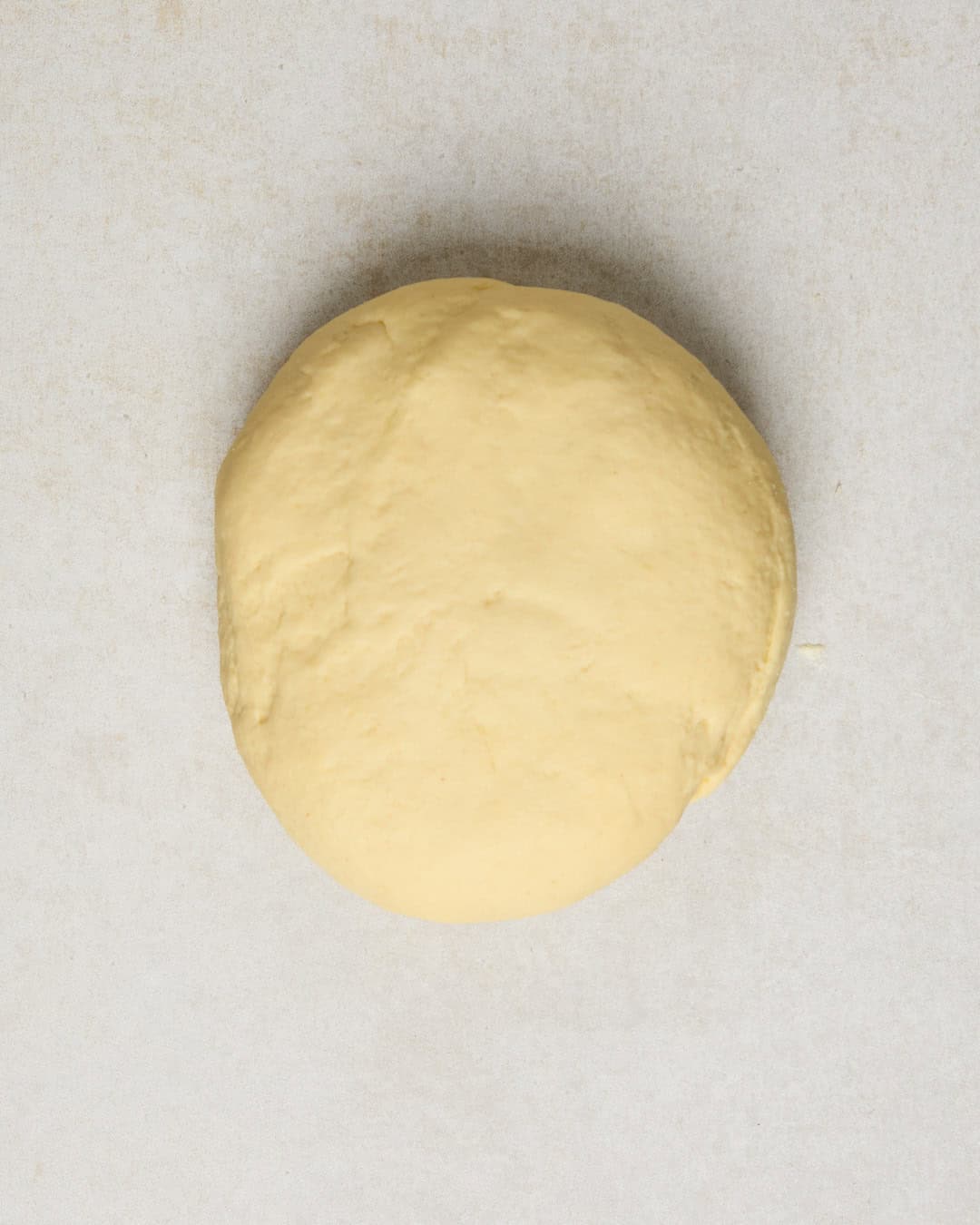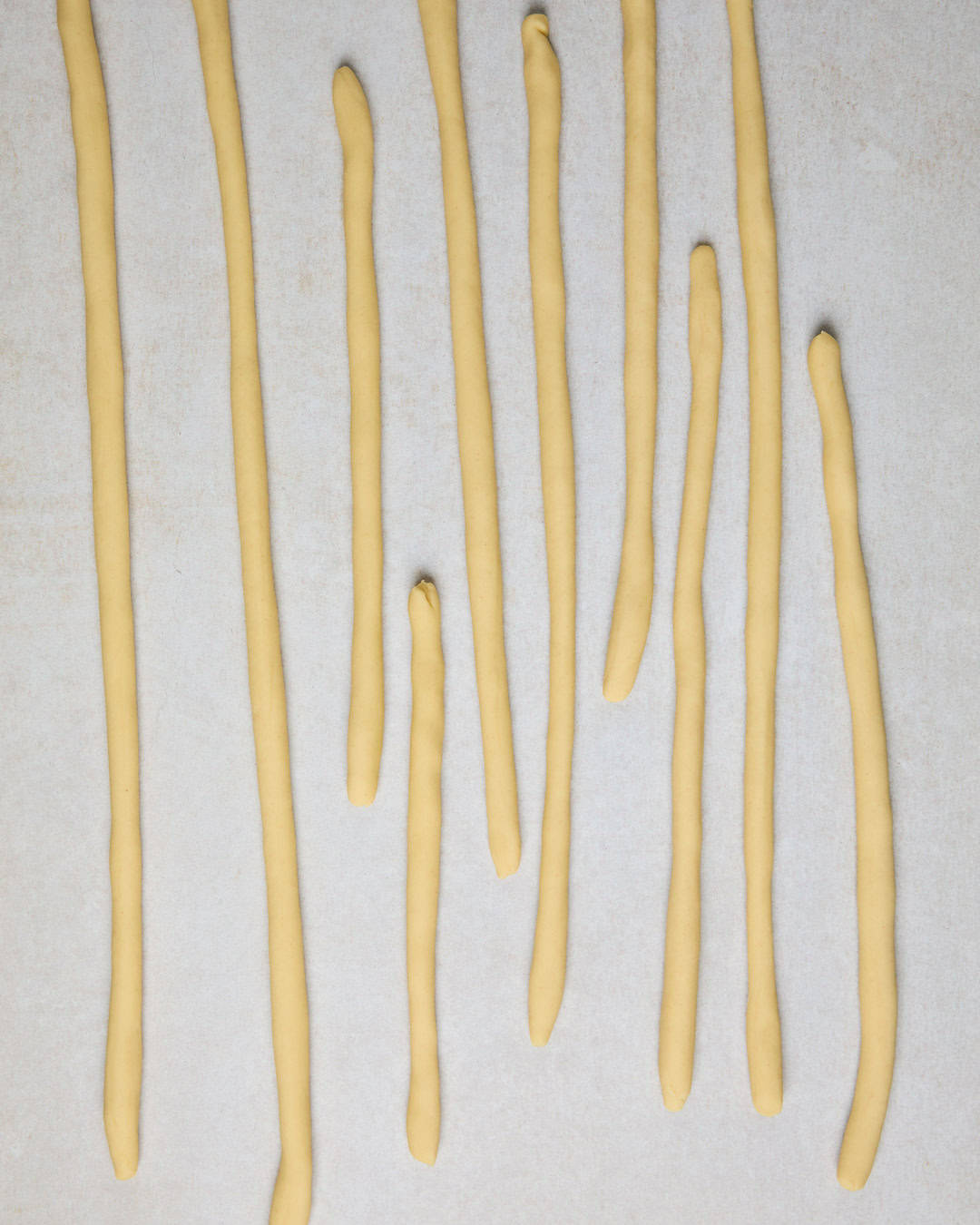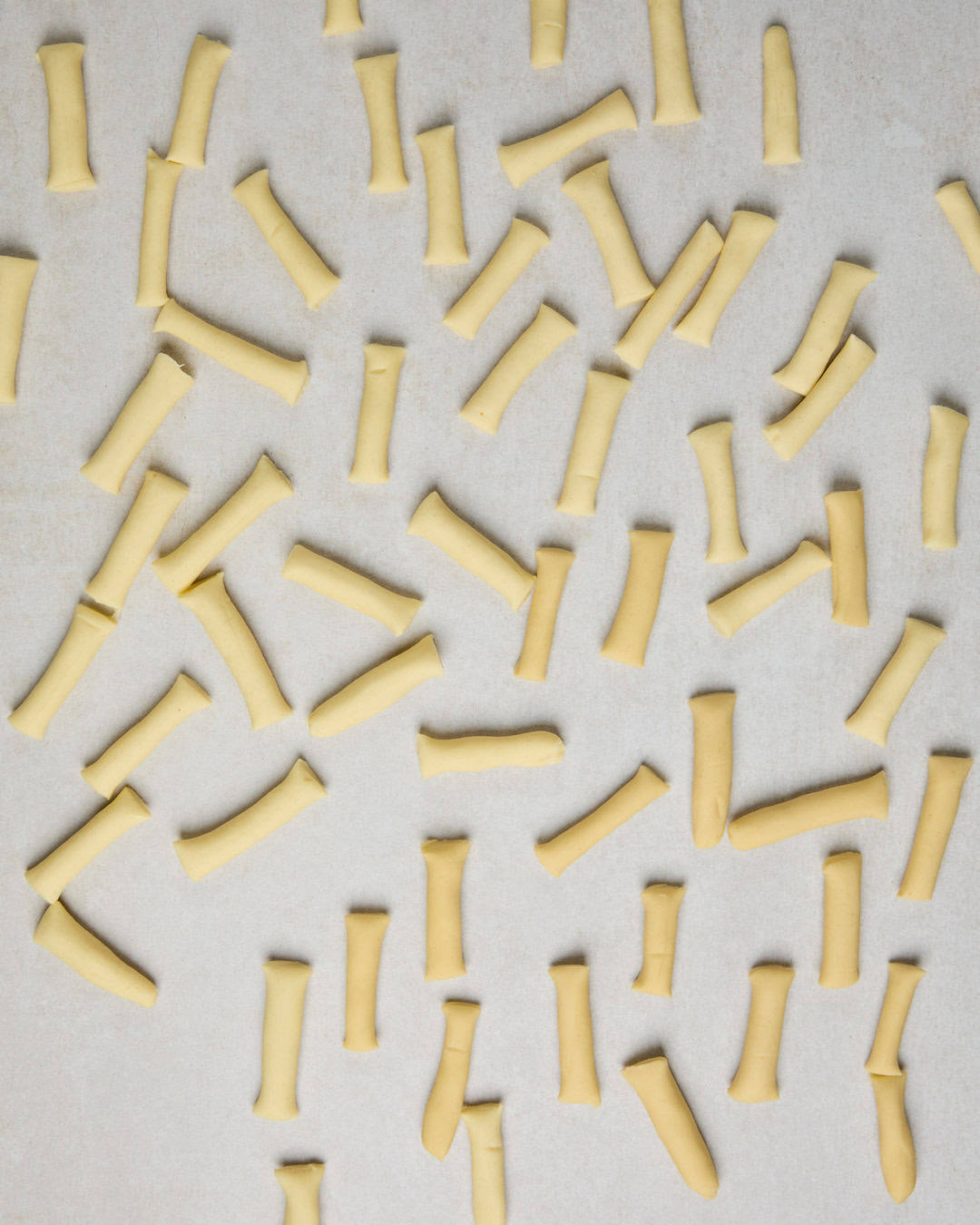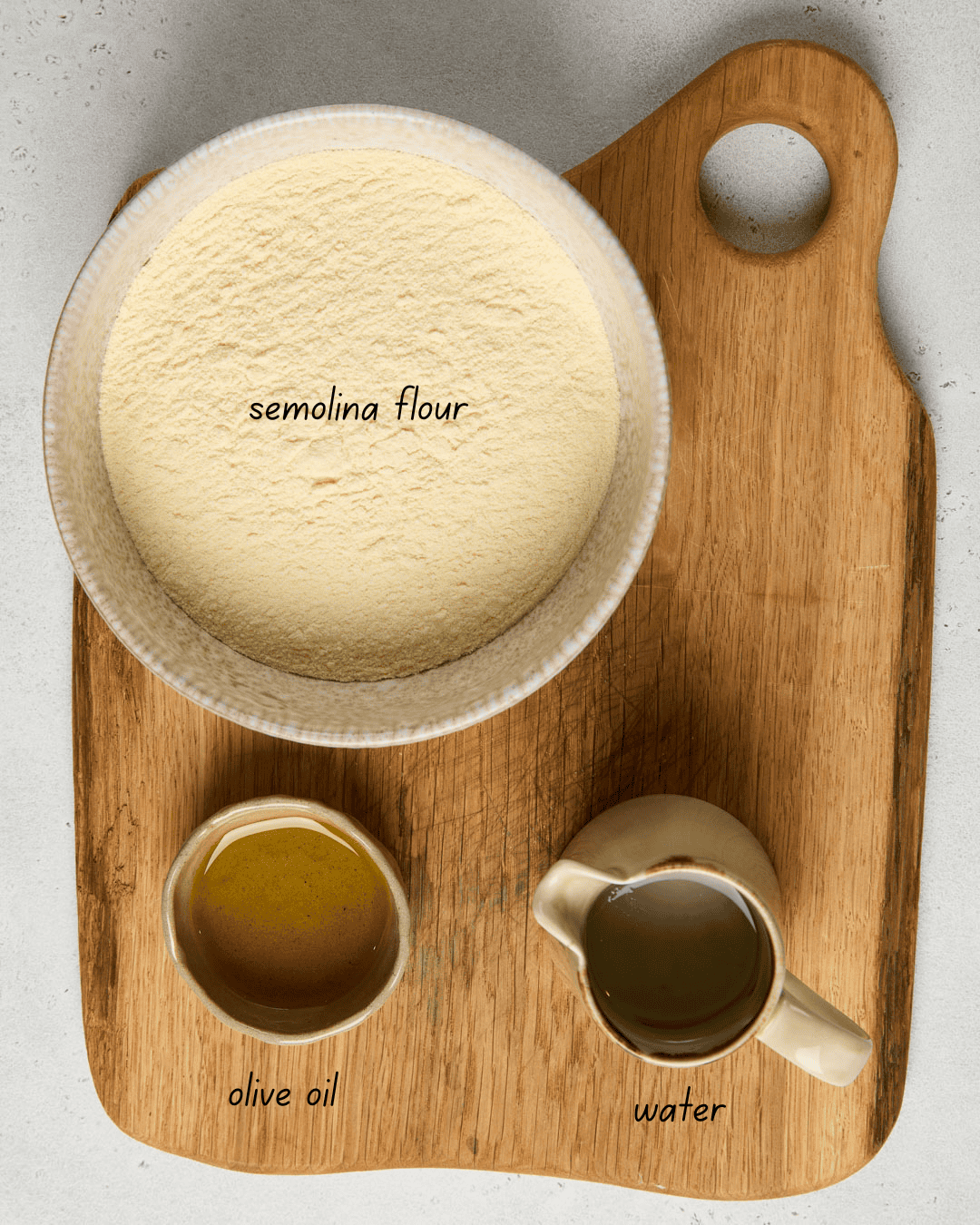Lolli con Fave (Pasta with Fava Beans)

What is Lolli con Fave?
Lolli con Fave is a traditional recipe from Modica, Sicily. It champions the local Fava Cottoia di Modica beans (broad beans), which are protected under the Slow Food presidium. This specific fava bean variety can be difficult to find outside of Sicily, but you can substitute them with Egyptian-style large fava beans, or even other similar-sized beans (cooking time might vary). This is a scrumptious example of the ingenious cooking of Cucina Povera, Italy’s kitchen of the poor. Thanks to a few simple techniques, it turns a humble assortment of veg, beans and freshly made pasta into a hearty and creamy one-pot dish that just happens to be vegan.
It’s the unique way this dish is cooked that turns it into something special. By adding common veg like onion, celery and carrot to the pan along with the beans, they slowly turn the water into a veg stock as it simmers, thereby flavouring the beans. The addition of a diced, peeled potato is another clever Cucina Povera trick. By the time the beans are fully cooked, the potato will have disintegrated into the stock, turning it rich and creamy.

History of Lolli con Fave
Lolli con Fave has its roots in Southern Italy, particularly in the regions of Sicily, where fava beans are commonly grown. Fava beans, known for their earthy, nutty flavor, have been a staple in Italian cuisine for centuries. The addition of semolina pasta, or “lolli,” makes this dish both hearty and fulfilling, creating a perfect harmony between the creamy beans and chewy pasta. It’s a rustic dish often made in homes during the colder months, with families gathering around the table to share a warm, comforting meal.
Ingredients You’ll Need & How to Substitute
- Fava Beans: The heart of Lolli con Fave, giving it a creamy and earthy flavor. Traditionally, the broad bean variety Fava Cottoia di Modica is used, but you can substitute with Egyptian-style fava beans. Other legumes like chickpeas are also commonly paired with pasta in Italy and can be used, though they won’t give the characteristic flavor that this dish is known for.
- Baking Soda: Helps soften the fava beans while they soak. If you don’t have baking soda, you can soak the beans with 1 tablespoon of salt, but they might need a little longer to cook.
- Onion: Adds depth of flavor to the stew. You can substitute with shallots if desired.
- Potato: Acts as a thickener and contributes creaminess to the stew. You can also make a simple roux of just a little flour and water and carefully whisk this into the stew to thicken it.
- Carrot: Adds sweetness and color to the dish.
- Celery: Brings a mild, aromatic flavor to the stew.
- Bay Leaf: Adds a fragrant, herbal note to the stew. If you don’t have bay leaves, you can substitute with a small sprig of thyme or a pinch of dried oregano.
- Tomato Paste: Provides richness and umami.
- Extra Virgin Olive Oil: Adds richness and flavor to the dish.
- Chilli Flakes: Adds a touch of heat and spice. You can adjust the amount to your preference or leave out entirely if you prefer a milder dish.
How to Make Lolli con Fave (Step-by-Step)

Prepare the Fava Beans. Begin by soaking dried fava beans in 1.5 liters of water with baking soda overnight. This softens the beans, making them easier to cook. The next day, drain and rinse the beans. In a large pan, combine the soaked beans with the onion, potato, carrot, celery sticks, bay leaf, tomato paste and water. Bring everything to a boil, then reduce the heat and let it simmer. Cover the pan and cook for 1 1/2 hours, stirring occasionally to avoid the beans sticking to the bottom. The beans should be tender, and the potatoes should begin to disintegrate into the stew.



Season the Stew. Once the beans are cooked and the potatoes have broken down, season the stew with salt and a generous drizzle of extra virgin olive oil. Let it simmer for another 10 minutes to let the flavors meld together.
Make the Pasta Dough. While the stew is cooking, it’s time to make the lolli. On a clean work surface, mound the semolina flour and create a well in the center. Add the salt and extra virgin olive oil into the well.

Slowly pour in lukewarm water and mix everything together until a rough dough forms. Knead the dough for about 5 minutes until it becomes smooth and elastic. Optionally, let the dough rest for 30 minutes, covered with a towel or a bowl, to allow the gluten to relax and make shaping easier.

Shape the Lolli. Once the dough has rested, divide it into ½ cm slices.


Roll each slice into 1 cm wide cords.

Cut the cords into 5 cm pieces, then use your fingers to drag each piece across the surface, creating the traditional lolli shape. Place the shaped pasta on a lightly floured tray to prevent sticking.


Cook the Lolli. Add the lolli directly into the pan with the beans and pour in enough boiling water to cover the pasta. Let it cook for about 10 minutes, stirring occasionally to prevent the pasta from clumping together. The lolli should be soft with a pleasant chew. As the pasta cooks, the liquid in the stew will thicken into a creamy sauce. If the stew is too thick, add a bit more boiling water to loosen it; if it’s too thin, let it simmer uncovered until it thickens to your desired consistency.

Serve. Once the lolli is cooked, divide the dish between plates. Finish with a drizzle of extra virgin olive oil and a sprinkle of chili flakes for a touch of heat and extra flavor.

Useful Tips
- Saving Time: While the process of cooking fava beans and making pasta from scratch really helps to develop the best flavor and texture, you can save time by using store-bought pasta. However, I would advise against using jarred or tinned beans, as they won’t allow enough time to create the creamy stock that makes this dish so special.
- Peeling the potato: I’m usually not a fan of peeling vegetables, because a lot of the nutrients sit right under the skin. For this dish, however, peeling the potato allows it to disintegrate and naturally thicken the stew.
- Pasta Dough: Don’t worry if the pasta dough feels too stiff at first. It will relax a little bit while it rests. If it feels dry, however, add a little bit more water. If it feels too sticky, dust it with a bit more flour and knead a little longer. You can also allow the dough to rest for 30 minutes, which will help with shaping and improve the final bite.
- Cover the Dough: Make sure to cover the lolli dough with a damp cloth or reusable plastic bag while it rests. This prevents it from drying out and helps keep the dough moist for easier shaping.
- Leftovers: If you’re keeping leftovers for the next day, remove the amount of stew you want to save before adding the pasta. Let any leftover pasta dry on a tray at room temperature to avoid it soaking up too much liquid and becoming soggy. When you’re ready to serve, simply cook the pasta fresh with the stew.
- Pressure Cooker: To cook the beans in a pressure cooker, use only 750ml of water and add the salt and olive oil as well. Cook for around 15 minutes, then stir in the pasta and continue as above.
Why You’ll Love This Lolli con Fave Recipe
- naturally & traditionally vegan
- easy to make, especially when substituting the fresh pasta with a dry variety
- packed with nutrition
How to Store Lolli con Fave
Refrigerate any leftover stew for 2-3 days. If you have extra pasta, dry it out on a tray at room temperature for 1-2 days before storing it in a jar for up to a week.
Other Italian Recipes You Might Like
- Ribollita: Tuscany’s vegetable, bean and bread stew
- Pappa al Pomodoro: A comforting bread and tomato soup
- Pane e Panelle: Sicilian chickpea fritters packed into a burger bun
As an Amazon Associate I receive a small commission from affiliate links on this page.

Lolli con Fave (Pasta with Fava Beans)
Ingredients
Fava Beans
- 300 g fava beans
- 1 tsp baking soda
- 1 small onion
- 1 potato
- 1 carrot
- 2 celery sticks
- 1 bay leaf
- 1 tbsp tomato paste
- 1 l water
- 1 tbsp salt
- Extra virgin olive oil
- Chilli flakes
Lolli
- 300 g semolina flour (durum wheat flour)
- 1/2 tsp salt
- 1 tbsp extra virgin olive oil
- 150 ml lukewarm water
Instructions
- Soak the fava beans together with the baking soda in around 1.5l of water overnight.
- The next day, peel and roughly chop the onion and potato, then roughly chop the carrot and celery sticks. Drain the fava beans, give them a rinse and add them to a large pan along with the chopped veg, bay leaf, tomato paste and water. Bring to a boil, then cover the pan with a lid and cook for 1 1/2 hours or until the fava beans are tender and the potatoes have disintegrated, stirring occasionally to avoid the starches sticking to the bottom of the pan (see Notes to use a pressure cooker). Also make sure you have plenty of space left in the pan, otherwise the liquid will rise and boil over. If the pan isn’t large enough, keep the lid ajar and top up the water when necessary.
- In the meantime, make the lolli. Tip the flour onto a work surface and make a well in the middle. Add the salt and extra virgin olive oil to the well, then pour in about half of the water and begin to mix everything together into a rough dough, adding the rest of the water little by little as you go. Once it’s all come together, knead the dough for around 5 minutes until it is smooth and elastic. At this point, you can cover the dough with a bowl and let it rest for 30 minutes to let the gluten develop, which will make it easier to handle. But for this pasta shape you can also continue straightaway. When you’re ready, cut the dough into 1/2 cm slices and roll each slice into a 1 cm wide cords, similar to breadsticks (make sure to cover the dough you’re not handling with a towel to prevent it from drying out). Then use a knife to cut each cord into 5 cm pieces. Use your index, middle and ring finger to drag each piece of dough over the surface to make the lolli shape. Continue with the rest of the dough until all of the pasta is ready. You can keep the shaped pasta on a lightly floured baking tray until later.
- At this point, the fava beans should have absorbed most of the water but still be just about covered. Season them with the salt and a generous drizzle of extra virgin olive oil and cook for another 10 minutes to let the beans absorb the salt. In the meantime, bring a kettle of water to a boil.
- Add the lolli straight into the pan with the beans*, add enough boiling water from the kettle to generously cover them and cook them for around 10 minutes until they still have a pleasant chew, but no chalkiness in the centre. By now, the leftover liquid should have turned into a creamy sauce, but you can still remove any excess water if necessary.
- *Tip: If I intend to keep half of the stew for the next day, I also only cook half of the pasta. In that case, dust a baking tray with semolina flour, transfer half of the lolli onto the tray and leave them overnight.
- When the pasta is ready, divide the lolli con fave over 4 plates and finish it with some chilli flakes and a drizzle of extra virgin olive oil.



WHOA!
Haha ☺️
Thank you for this recipe and your efford, I had this one saved on instagram for half of the year and now i am finally making this dish!!! I am so excited, thank you for all the work you did.
I wish you all the best, all the love ♥
Amazing!! Hope you liked it! ☺️
Looks amazing, can’t wait to make the dish myself! Quick question: do you eat the fava beans with the skin? (sorry, if it is a weird question, but my mother has always skined fresh fava beans after cooking them -but maybe there are different recommedations for fresh and dried beans?). And would the recipe also work with fresh fava beans?
Yes, you can eat the skins. They are quite tough, but soaking them in the baking soda solution overnight really helps. Plus, they are packed with nutritious fibres. Using fresh will change the nature of the dish quite a bit. You can, but you’ll have to adjust the water quantity and cooking times, plus it won’t be quite as creamy.
Hello Julius! I recently discovered you through You Tube and I am delighted at the way you cook. I can’t wait to have your cookbook. Admitedly, Argentina (where I’m from) is not very ‘naturally vegan’ so to speak. We do, however have some vegan dishes which you may like among which is Ensalada Criolla, Chimichurri, dulce de membrillo or some breads which I urge you to try. Keep on with the good work!
Thank you so much! 🙂 And thanks for the tips, can’t wait to try those!